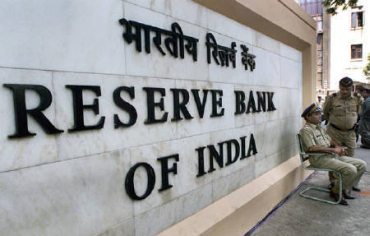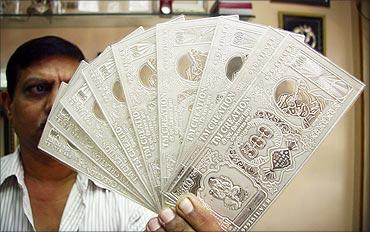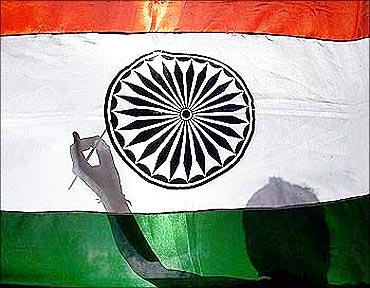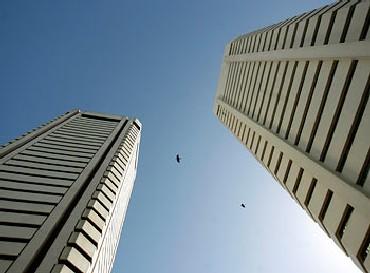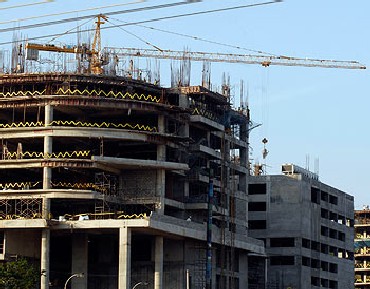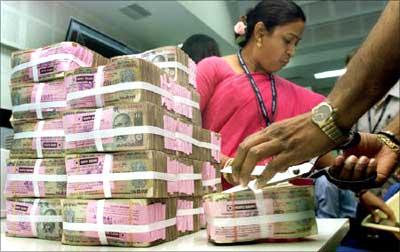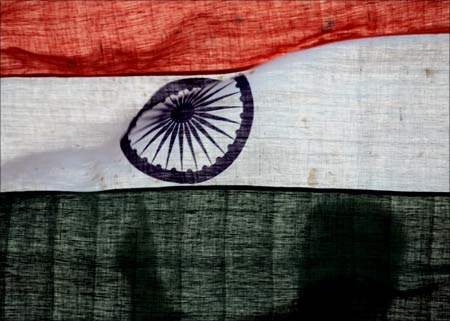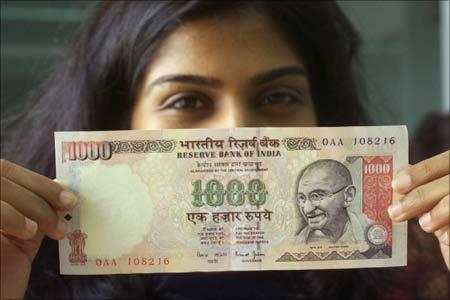 | « Back to article | Print this article |
Past imperfect, future tense for India Inc
CEOs, bankers say worse than current slowdown is uncertainty on coming quarters, prepare survival plans.
This year's 'Diwali Dhamaka' didn't quite live up to its name.
And, Future Group chairman Kishore Biyani, who has copyright on the famous ad tagline, admits even steep discounts didn't help much in many regions this year.
"Diwali sales in many regions have been inconsistent. They have slowed. There were weaknesses in certain categories," he says.
Biyani's flagship listed company, Pantaloon Retail, saw growth of only 3.5 per cent in same-store sales in the second quarter of this year in its value segment.
That's the lowest in the past eight quarters.
Engineering heavyweight Larsen & Toubro has a similar concern.
Click NEXT to read further. . .
Past imperfect, future tense for India Inc
"Conditions have undergone a sea change. There has been a slowing of investment and projects are getting reviewed," says chief financial officer R Shankar Raman.
India Inc stares at a combination of unfavourable factors -- high interest rates, almost double-digit inflation, eroding consumer confidence and all-round global economic sluggishness.
It's no surprise that it's the first quarter in two years when the Nifty 50 companies saw a fall in profits.
And, a combination of subdued sales and high costs have kept operating margins from expanding; in the September quarter, they fell 400 basis points over the year.
Koushik Chatterjee, group CFO, Tata Steel, says the higher coking coal prices in India have hit margins.
Though Tata Steel Europe posted a 19 per cent growth in sales, operating profit fell 43 per cent due to lower steel prices and higher coking coal and iron ore prices.
Car manufacturers are perhaps the worst hit. Maruti Suzuki had started the year with a target to increase sales by 13 per #162 Suzuki chairman O Suzuki brought it down to only five per cent.
Click NEXT to read further. . .
Past imperfect, future tense for India Inc
"Even that is difficult to achieve. I will be happy with three per cent growth, but that can be possible only if we sell well in the next few months," says managing director R C Bhargava.
Two-wheeler companies are better off, as 70 per cent of their sales are in cash and rural sales are still on course.
Even then, last year's magic growth is a distant memory.
However, Bajaj Auto's MD, Rajiv Bajaj, downplays the sombre mood: "There are some concerns as sales growth has been only two per cent in October, but that is because the festival season was in October, so our peak sales were in September. So, the slow growth is artificial.
"We will surely not see 20 per cent growth like last year but it could be anything from eight to 12 per cent."
Click NEXT to read further. . .
Past imperfect, future tense for India Inc
While the slowdown was anticipated, what is causing concern is the way forward. Take L&T.
The 23 per cent slump in orders in the engineering and construction segment in the second quarter was bad enough; what is worse is that L&T has reduced the full year outlook for order inflows to just five per cent, from the earlier 15 per cent.
Fearing a demand slowdown, fresh investments by many companies are on hold. And, infrastructure projects such as roadways are moving at a snail's pace.
Listen to ICICI Bank MD & CEO Chanda Kochhar: "The current credit growth is still coming from past sanctions that are now getting disbursed. The new approval rate has gone down, as there are no projects or very few projects coming for financial closure."
Some bankers are even expecting credit growth to shrink to 14 per cent in the next financial year from an expected 18 per cent this year, as companies prefer to wait and watch rather than take a loan at high cost.
Click NEXT to read further. . .
Past imperfect, future tense for India Inc
Chiefs of construction and infrastructure businesses agree.
"Large orders for the infrastructure and construction sector have dropped by 36 per cent over last year," said a worried Ajit Gulabchand, chairman and managing director of Hindustan Construction Corporation.
Industries dependent on infrastructure growth are seeing red ahead. In the past 12 months, for instance, the steel industry added eight million tonnes of capacity, based on the assumption that sales growth would be at last year's level of 12 per cent.
"Steel consumption by the auto industry has gone down.
"The intensity of steel consumption has got adversely impacted because construction, real estate and infrastructure projects are not coming up. So, steel demand is not more than 3.5 to four per cent," says Malay Mukherjee, CEO of Essar Steel.
Click NEXT to read further. . .
Past imperfect, future tense for India Inc
In real estate, the growing number of unsold inventory could pose serious problems to companies in the next few months.
"I think home sales are half of last year's levels. If this slowdown persists, it will be really tough for developers.
"Developers have to absorb four to five per cent of the interest which buyers pay and do something to sell their products," says Pujit Aggarwal, managing director and CEO, Orbit Corporation, a Mumbai-based developer.
Even FMCG (fast moving consumer goods) companies, which had declared decent revenue growth numbers in the second quarter, primarily because they have partly passed on the rise in raw material costs to consumers, are circumspect about the future, as rural demand is slowing.
Click NEXT to read further. . .
Past imperfect, future tense for India Inc
Marico chairman Harsh Mariwala says there is always a lag effect of three to six months for FMCG in demand and, "I think we will see the slowdown in the next few quarters.
Government finances are strained, so we don't think they will be able to pump in more money through various rural schemes like NREGS and push rural demand any more."
Dabur India, which has increased its product prices at least twice this year, says it will have no choice but to sacrifice margins if raw material prices do not come down.
Dabur CEO Sunil Duggal said, "We had to increase our prices by seven per cent, but our cost increase was 10 per cent.
"But if raw material costs continue to go up, we cannot go on increasing prices, so we will have to sacrifice margins instead of our market share. Rural offtake has got more affected than urban demand," he added.
Click NEXT to read further. . .
Past imperfect, future tense for India Inc
Some are hoping rural markets will save them.
Videocon Industries' chairman Venugopal Dhoot said he had expected sales to grow by around 25 per cent, but he would be happy if that number was between 12 and 15 per cent.
"Rural sales, however, continue to be good," he said.
The silver lining is that India Inc is aware of the new reality and is going back to the drawing board for survival strategies.
Clearly, the 2008 lessons have been learnt. Many looking at exporting out of trouble, with the dramatic depreciation of the rupee a great help for some.
"The depreciation has given us a new opportunity. We are pushing exports and hope 20 per cent of our sales will come from there," says Dhoot, who is pushing TV exports more aggressively.
Bajaj Auto saw a growth of 40 per cent in its export sales growth in April-Ju#8800 last year, the growth was 20 per cent.
Click NEXT to read further. . .
Past imperfect, future tense for India Inc
"We are now aggressively pushing for exports of two-wheelers, which will help us tide over the slowdown in the domestic market," says Bajaj.
Auto companies are hoping new car launches will do the trick. At least 55 new models for vehicles will be launched in the Auto Expo in January next year from all top companies.
Maruti Suzuki is talking to Fiat, which has surplus capacity in its plant so that it can quickly get more diesel engines to power its cars and push up sales in the remaining months.
It is also pushing through an aggressive plan under which the 200-odd vendors will have to cut their costs by three per cent, which will save them about Rs 700 crore (Rs 7 billion).
Click NEXT to read further. . .
Past imperfect, future tense for India Inc
The other good news is unlike 2008, no company is yet looking at mass layoffs. They are, instead, looking at multi-tasking of existing employees.
"A one-size fits all, across the board salary reduction or layoffs are not the immediate reaction. Companies know retaining key talent is crucial; the focus is on optimisation," says Vivek Nath, managing director, India, of Towers Watson India, a human resource firm.
That's something everybody is hoping for -- that India Inc is in a better position than in 2008 to cope with the long winter ahead.
With inputs from</I> <B>Raghavendra Kamath, Chandan Kishore Kant & Shubhashish

